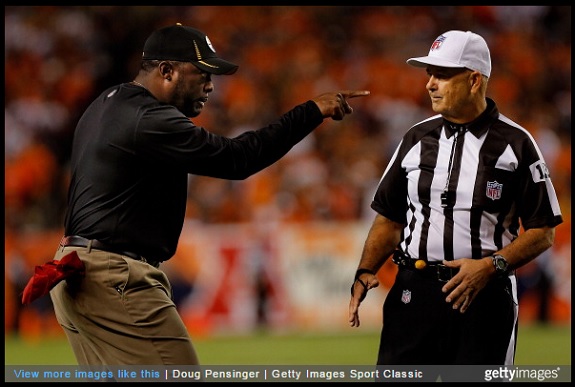While the vast majority of the NFL, coaching circles, and the Pittsburgh Steelers fan base regards Mike Tomlin as a good head coach, there is one area of coaching in particular that has, with relative consistency, been cited as a weakness in his game day performance, and it seemed to be on display last night during the season opener.
Tomlin, and quarterback Ben Roethlisberger, are often criticized for the manner in which they handle clock management issues. Though this is a concern that I often regard as exaggerated—the Steelers scored more points than any team last season in the last two minutes of halves—last night was certainly one that was hard to ignore.
With the Steelers trailing 14-0 at the end of the second quarter, Roethlisberger got the ball back at his own 17-yard line with approximately four minutes remaining, as well as three timeouts. The drive ended with a field goal kicked with seven seconds left on the clock.
The offense ran seven plays, including penalties, before using its first timeout, converting a fourth-and-three opportunity down to the Patriots’ 31-yard line. There were 43 seconds remaining at that point.
It was the only timeout that they used during the half to stop the clock. The next play was a running play that gained five yards, with the ball carrier tackled inbounds. Roethlisberger and Tomlin allowed the clock to run down to 19 seconds rather than using a timeout following the play.
It was as though they were counting on the following play to work, after targeting Darrius Heyward-Bey in the end zone from the 26-yard line. While it should have gone for a touchdown, there is little excuse for burning 24 seconds with well less than a minute left in a half when you are only on the 26-yard line.
The Steelers were left with just 13 seconds after that on the 26-yard line, which curtailed their play calling selections. The third down pass fell incomplete, and they were forced to settle for a field goal attempt on a drive that readily promised the potential for more.
The Steelers also go the ball back trailing by 14 points once again to second the second half. With three minutes to play, Pittsburgh once again had all three of its timeouts, but by the way the drive was executed, you wouldn’t know that they were down by two scores.
The time that passed between Roethlisberger’s first completion and the next play run was 34 seconds, with the clock draining from 2:52 to 2:18. They then failed to get another play off after that subsequent play before the two-minute warning, missing doing so by less than a second.
Roethlisberger ended up throwing a touchdown pass to end the drive, but he left just two seconds on the clock in the process. It would have taken the lowest of low-percentage plays on the ensuing onside kick attempt to return the kick for a touchdown to tie the game. The Steelers hurt themselves in many different ways on the night, and this was just one of them.








